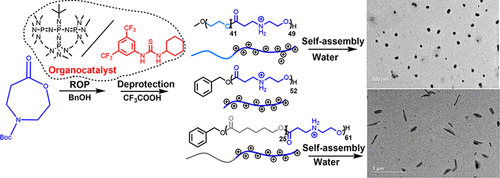当前位置:
X-MOL 学术
›
Macromolecules
›
论文详情
Our official English website, www.x-mol.net, welcomes your feedback! (Note: you will need to create a separate account there.)
Poly(amine-co-ester)s by Binary Organocatalytic Ring-Opening Polymerization of N-Boc-1,4-oxazepan-7-one: Synthesis, Characterization, and Self-Assembly
Macromolecules ( IF 5.5 ) Pub Date : 2019-12-27 , DOI: 10.1021/acs.macromol.9b02084 Xin Wang 1 , Nikos Hadjichristidis 1
Macromolecules ( IF 5.5 ) Pub Date : 2019-12-27 , DOI: 10.1021/acs.macromol.9b02084 Xin Wang 1 , Nikos Hadjichristidis 1
Affiliation

|
Binary organocatalytic ring-opening polymerization (ROP) of N-Boc-1,4-oxazepan-7-one (OxPBoc) is proposed as a versatile method to generate metal-free poly(amine-co-ester)s and the corresponding biodegradable polycationic homo/block (co)polymers. Optimization experiments with different organocatalysts, including 1,8-diazabicyclo[5.4.0]undec-7-ene (DBU), 1,5,7-triazabicyclo[4.4.0]dec-5-ene (TBD), DBU/1-(3,5-bis(trifluoromethyl)phenyl)-3-cyclohexylthiourea (TU1), and phosphazene/thiourea, revealed that t-Bu-P4/TU1 leads to a fast and controlled/living ROP with benzyl alcohol (BnOH) as an initiator and thus allows the formation of well-defined poly(amine-co-ester)s with high molecular mass (Mn,SEC up to 38.8 kg mol–1) and narrow dispersity. Well-defined poly(N-Boc-1,4-oxazepan-7-one)-based diblock copolymers were also synthesized successfully via the controlled/living ROP, regardless of whether hydrophilic poly(ethylene glycol) (PEG) or hydrophobic polycaprolactone (PCL) was used as a macroinitiator. After treatment with trifluoroacetic acid, the corresponding water-soluble polycationic homopolymer, as well as the hydrophilic (PEG-based copolymer) and amphiphilic (PCL-based copolymer) polycationic diblock copolymers, was obtained. Dynamic light scattering in water and transmission electron microscopy analyses revealed that both polycationic copolymers self-assembled spontaneously to nanostructures; the hydrophilic block copolymer formed spherical nanoparticles, while the amphiphilic one formed rod-shaped nanoparticles.
中文翻译:

N -Boc-1,4-oxazepan-7-one的二元有机催化开环聚合反应制得的聚胺共酯:合成,表征与自组装
N - Boc -1,4-oxazepan-7-one(OxP Boc)的二元有机催化开环聚合(ROP)被提出作为一种通用的方法来生成无金属的聚(胺-共酯)和相应的可生物降解的聚阳离子均聚物/嵌段(共)聚合物。不同有机催化剂的优化实验,包括1,8-二氮杂双环[5.4.0]十一碳-7-烯(DBU),1,5,7-三氮杂双环[4.4.0] dec-5-烯(TBD),DBU / 1 -(3,5-双(三氟甲基)苯基)-3-环己基硫脲和磷腈/硫脲显示t -Bu-P 4 / TU1可导致苯甲醇(BnOH)快速且可控制/有效地存在ROP作为引发剂,并因此允许明确定义的聚的形成(胺共-酯)具有高分子量(M n,SEC最高38.8 kg mol –1)并且分散性窄。定义明确的poly(N不管是使用亲水性聚乙二醇(PEG)还是疏水性聚己内酯(PCL),都可以通过受控/活性ROP成功合成基于-Boc-1,4-oxazepan-7-one的二嵌段共聚物。宏观引发剂。用三氟乙酸处理后,获得了相应的水溶性聚阳离子均聚物,以及亲水性(基于PEG的共聚物)和两亲性(基于PCL的共聚物)聚阳离子二嵌段共聚物。在水和透射电子显微镜分析中的动态光散射表明,两种聚阳离子共聚物均自发自组装成纳米结构。亲水性嵌段共聚物形成球形纳米颗粒,而两亲性则形成棒状纳米颗粒。
更新日期:2019-12-29
中文翻译:

N -Boc-1,4-oxazepan-7-one的二元有机催化开环聚合反应制得的聚胺共酯:合成,表征与自组装
N - Boc -1,4-oxazepan-7-one(OxP Boc)的二元有机催化开环聚合(ROP)被提出作为一种通用的方法来生成无金属的聚(胺-共酯)和相应的可生物降解的聚阳离子均聚物/嵌段(共)聚合物。不同有机催化剂的优化实验,包括1,8-二氮杂双环[5.4.0]十一碳-7-烯(DBU),1,5,7-三氮杂双环[4.4.0] dec-5-烯(TBD),DBU / 1 -(3,5-双(三氟甲基)苯基)-3-环己基硫脲和磷腈/硫脲显示t -Bu-P 4 / TU1可导致苯甲醇(BnOH)快速且可控制/有效地存在ROP作为引发剂,并因此允许明确定义的聚的形成(胺共-酯)具有高分子量(M n,SEC最高38.8 kg mol –1)并且分散性窄。定义明确的poly(N不管是使用亲水性聚乙二醇(PEG)还是疏水性聚己内酯(PCL),都可以通过受控/活性ROP成功合成基于-Boc-1,4-oxazepan-7-one的二嵌段共聚物。宏观引发剂。用三氟乙酸处理后,获得了相应的水溶性聚阳离子均聚物,以及亲水性(基于PEG的共聚物)和两亲性(基于PCL的共聚物)聚阳离子二嵌段共聚物。在水和透射电子显微镜分析中的动态光散射表明,两种聚阳离子共聚物均自发自组装成纳米结构。亲水性嵌段共聚物形成球形纳米颗粒,而两亲性则形成棒状纳米颗粒。


























 京公网安备 11010802027423号
京公网安备 11010802027423号